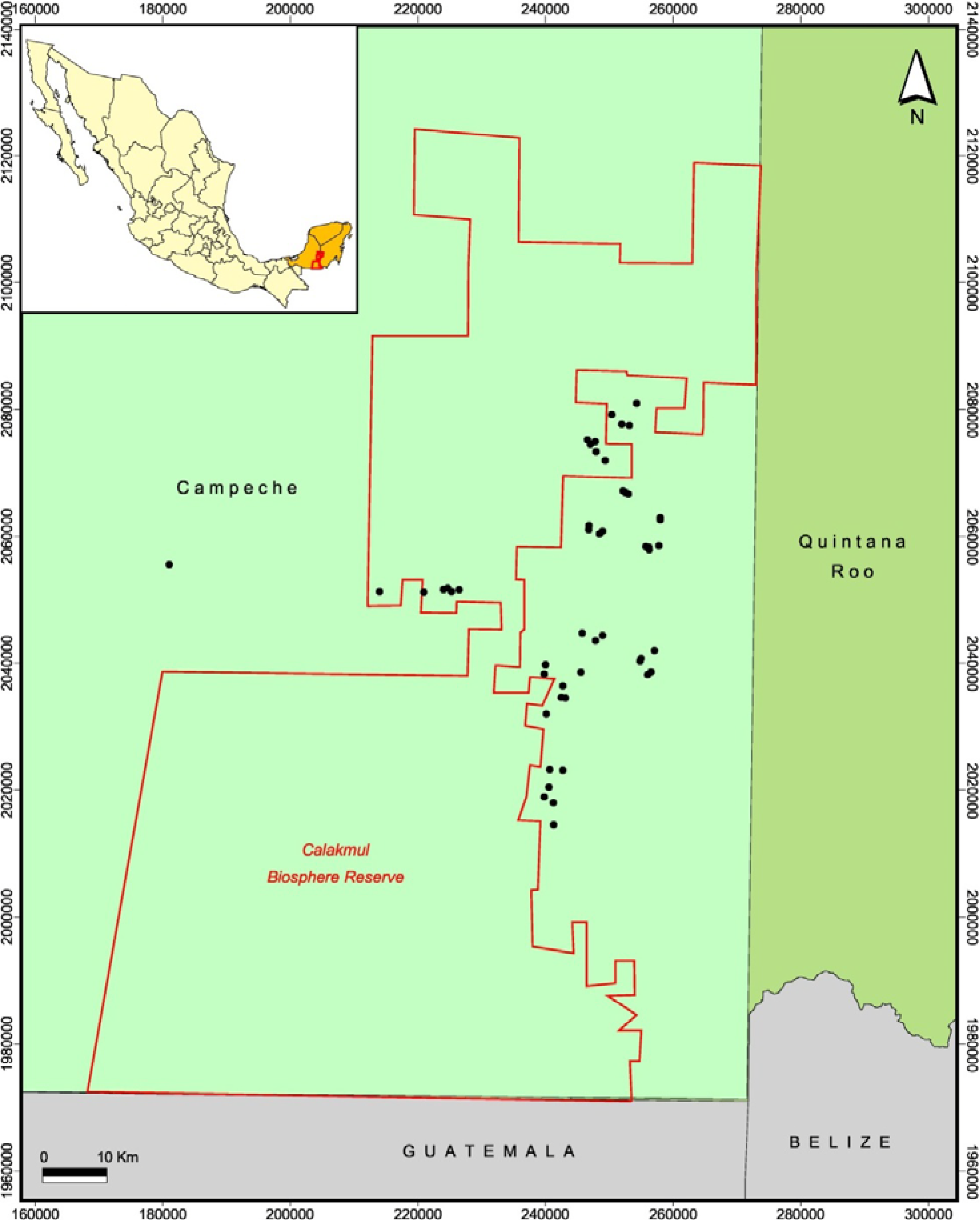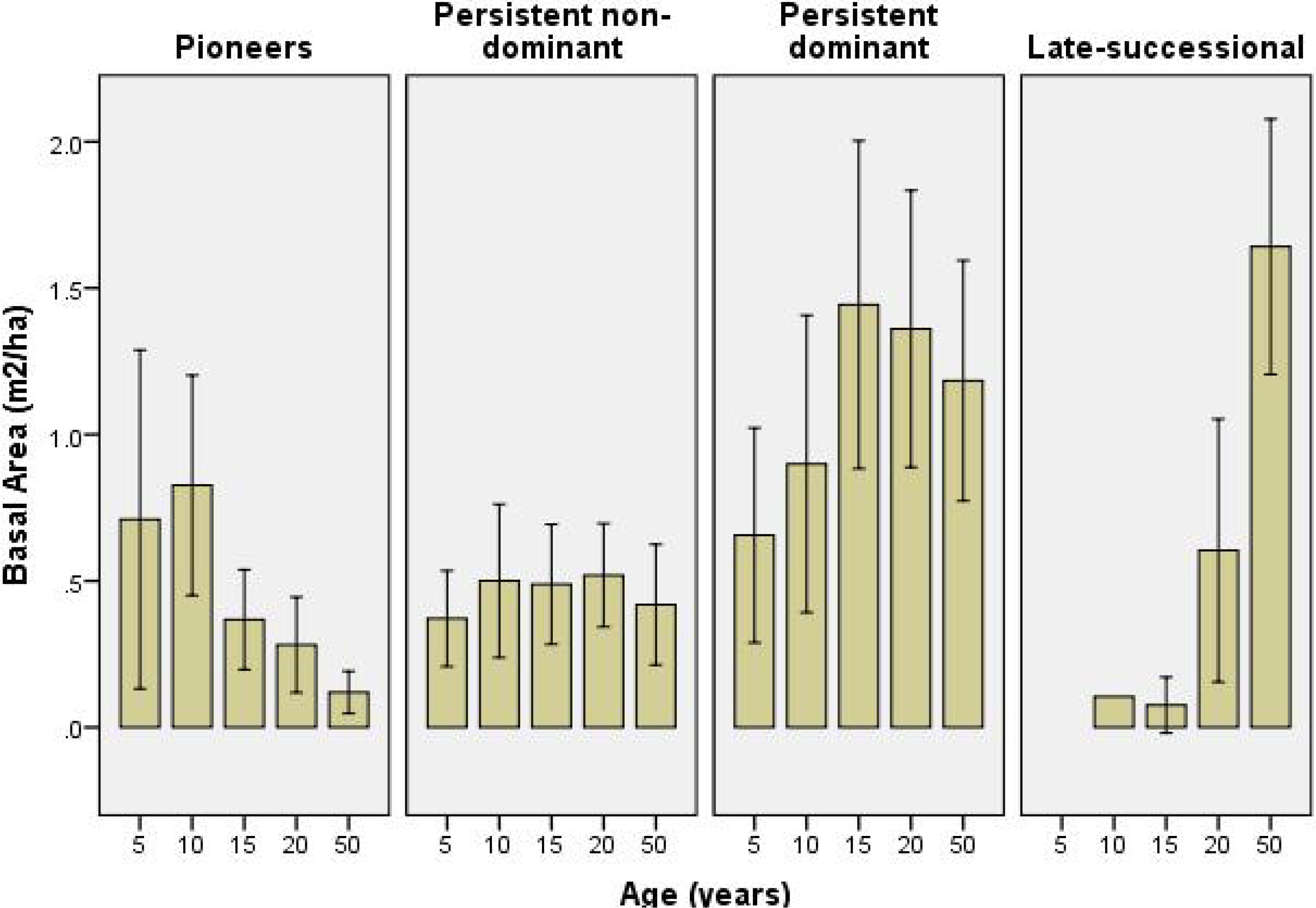Redefining Secondary Forests in the Mexican Forest Code: Implications for Management, Restoration, and Conservation
Abstract
:1. Introduction
2. Materials and Methods
2.1. Study Area

2.2. Workshops
2.3. Field Sampling
2.4. Data Analysis
3. Results and Discussion
3.1. Workshop Assessment
3.2. Forest Successional Trends
| Young Forest (<4–6 years) | Old-Growth Forest (30–50 years) | Forest Type | Location | Reference | |
|---|---|---|---|---|---|
| Basal Area (m2/ha) | 7.6 | 38.0 | Semi-evergreen | Southern Yucatan | [9] |
| 7.5 | 17.0 | Semi-evergreen | Eastern Yucatan | [17] | |
| 7.6 | 22.7 | Semi-evergreen | Southern Yucatan | This Study | |
| 10.0 | 31.2 | Seasonally dry | Central Yucatan | [18] | |
| 5.0 | 22.5 | Seasonally dry | Oaxaca | [19] | |
| 15.0 | 28.0 | Seasonally dry | Bolivia | [20] | |
| Stem Density (#/ha) | 20,000 (>1 cm dbh) | 10,000 (>1 cm dbh) | Semi-evergreen | Southern Yucatan | [9] |
| 22,000 (>2 cm dbh) | 4000 (>2 cm dbh) | Semi-evergreen | Southern Yucatan | This Study | |
| 6638 (>2 cm dbh) | 6644 (>2 cm dbh) | Seasonally dry | Central Yucatan | [18] | |
| 5000 (>1 cm dbh) | 4500 (>1 cm dbh) | Seasonally dry | Oaxaca | [19] | |
| 8000 (>2 m tall) | 4000 (>2 m tall) | Seasonally dry | Bolivia | [20] |
3.3. Potential Risks for Biodiversity Conservation

| Successional Groups | Source of Regeneration | |
|---|---|---|
| Stump Regrowth | Seeds | |
| Pioneer Species | 19 | 6 |
| Persistent Non-dominant Species | 37 | 5 |
| Persistent Dominant Species | 15 | 1 |
| Late-Successional Species | 3 | 14 |

3.4. Implications for Management, Restoration, and Conservation
3.5. Future Perspectives
4. Conclusions
Acknowledgments
Author Contributions
Conflicts of Interest
References
- Food and Agriculture Organization of the United Nations (FAO); International Tropical Timber Organization (ITTO). Forest Governance and Climate-Change Mitigation; Policy Brief, FAO/ITTO Initiative on Forest Law Compliance and Governance: Rome, Italy, 2009. [Google Scholar]
- Aronson, J.; Brancalion, P.H.S.; Durigan, G.; Rodrigues, R.R.; Engel, V.L.; Tabarelli, M.; Torezan, J.M.D.; Gandolfi, S.; de Melo, A.C.G.; Kageyama, P.Y.; et al. What role should government regulation play in ecological restoration? Ongoing debate in Sao Paulo State, Brazil. Restor. Ecol. 2011, 19, 690–695. [Google Scholar] [CrossRef]
- Comisión Nacional Forestal (CONAFOR). Ley General de Desarrollo Forestal Sustentable; Diario Oficial de la Federación (25 Febrero): México D.F., Mexico, 2003. Available online: http://www.diputados.gob.mx/LeyesBiblio/pdf/259.pdf (accessed on 12 June 2013).
- Comisión Nacional Forestal (CONAFOR). Reglamento de la Ley General de Desarrollo Forestal Sustentable; Diario Oficial de la Federación (21 Febrero): México D.F., Mexico, 2005. Available online: http://www.diputados.gob.mx/LeyesBiblio/regley/Reg_LGDFS.pdf (accessed on 12 June 2013).
- Instituto Nacional de Estadística, Geografía e Informática (INEGI). Información Geográfica; INEGI: México D.F., Mexico, 2005. [Google Scholar]
- Secretaría de Agricultura y Recursos Hidráulicos (SARH). Inventario Nacional Forestal Periódico (1992–1994); SARH: México DF, Mexico, 1994. [Google Scholar]
- Vester, H.F.M.; Lawrence, D.; Eastman, J.R.; Turner, B.L., II; Calme, S.; Dickson, R.; Pozo, C.; Sangermano, F. Land change in the southern Yucatan and Calakmul Biosphere Reserve: Effects on habitat and biodiversity. Ecol. Appl. 2007, 17, 989–1003. [Google Scholar] [CrossRef]
- Levy-Tacher, S.I.; Aguirre-Rivera, J.R. El aprovechamiento agrícola intensivo de los Hubchés (Acahuales o comunidades secundarias) de Yucatán. Rev. Geogr. 2000, 28, 79–103. [Google Scholar]
- Read, L.; Lawrence, D. Recovery of biomass following shifting cultivation in dry tropical forests of the Yucatan. Ecol. Appl. 2003, 13, 85–97. [Google Scholar]
- Ellis, E.A.; Porter-Bolland, L. Is community-based forest management more effective than protected areas? A comparison of land use/land cover change in two neighboring study areas of the Central Yucatan Peninsula, Mexico. For. Ecol. Manag. 2008, 256, 1971–1983. [Google Scholar]
- Instituto Nacional de Estadística, Geografía e Informática (INEGI). Campeche: Datos por Ejido y Comunidad Agraria. XI Censo General de Población y Vivienda, 1990; INEGI: Aguascalientes, México DF, Mexico, 1996. [Google Scholar]
- Martínez, E.; Galindo-Leal, C. La vegetación de Calakmul, Campeche, México: Clasificación, descripción y distribución. Bol. Soc. Bot. Méx. 2002, 71, 7–32. [Google Scholar]
- Sánchez-González, M.C. Calakmul, encuesta. In Proyecto de Evaluación de Áreas Naturales Protegidas de México; Gómez-Pompa, A., Dirzo, R., Eds.; Secretaría de Desarrollo Social, Sedesol: México DF, Mexico, 1993. [Google Scholar]
- Pennington, T.D.; Sarukhán, J. Árboles Tropicales de México, 3rd ed.; Universidad Nacional Autónoma de México y Fondo de Cultura Económica: México DF, Mexico, 2005. [Google Scholar]
- Fry, J.C. Biological Data Analysis. A Practical Approach; Oxford University Press: Oxford, UK, 1993. [Google Scholar]
- Levy-Tacher, S.I.; Aguirre-Rivera, J.R. Successional pathways derived from different vegetation use patterns by Lacandon Mayan Indians. J. Sustain. Agric. 2005, 26, 49–82. [Google Scholar] [CrossRef]
- Urquiza-Haas, T.; Dolman, P.M.; Peres, C.A. Regional scale variation in forest structure and biomass in the Yucatan Peninsula, Mexico: Effects of forest disturbance. For. Ecol. Manag. 2007, 247, 80–90. [Google Scholar] [CrossRef]
- Hartter, J.; Lucas, C.; Gaughan, A.E.; Aranda, L.L. Detecting tropical dry forest succession in a shifting cultivation mosaic of the Yucatan Peninsula, Mexico. Appl. Geogr. 2008, 28, 134–149. [Google Scholar] [CrossRef]
- Lebrija-Trejos, E.; Pérez-García, E.A.; Meave, J.A.; Bongers, F.; Poorter, L. Functional traits and environmental filtering drive community assembly in a species-rich tropical landscape. Ecology 2010, 91, 386–398. [Google Scholar]
- Kennard, D.K. Secondary forest succession in a tropical dry forest: Patterns of development across a 50-year chronosequence in lowland Bolivia. J. Trop. Ecol. 2002, 18, 53–66. [Google Scholar] [CrossRef]
- Whitmore, T.C. Canopy gaps and the two major groups of forest trees. Ecology 1989, 70, 536–538. [Google Scholar] [CrossRef]
- Gourlet-Fleury, S.; Blanc, L.; Picard, N.; Sist, P.; Dick, J.; Nasi, R.; Swaine, M.; Forni, E. Grouping species for predicting mixed tropical forest dynamics: Looking for a strategy. Ann. For. Sci. 2005, 62, 785–796. [Google Scholar] [CrossRef]
- Negreros-Castillo, P.; Hall, R.B. Sprouting capability of 17 tropical tree species after overstory removal in Quintana Roo, Mexico. For. Ecol. Manag. 2000, 126, 399–403. [Google Scholar] [CrossRef]
- Clarke, P.J.; Lawes, M.J.; Midgley, J.J.; Lamont, B.B.; Ojeda, F.; Burrows, G.E.; Enright, N.J.; Knox, K.J.E. Resprouting as a key functional trait: How buds, protection and resources drive persistence after fire. New Phytol. 2013, 197, 19–35. [Google Scholar] [CrossRef]
- Hernández-Xolocotzi, E.; Bello, E.; Levy-Tacher, S. La Milpa en Yucatán, un Sistema de Producción Agrícola Tradicional; Colegio de Postgraduados: Montecillos, México, 1995. [Google Scholar]
- Hernandez-Stefanoni, J.L.; Dupuy, J.M. Effects of landscape patterns on species density and abundance of trees in a tropical subdeciduous forest of the Yucatan Peninsula. For. Ecol. Manag. 2008, 255, 3797–3805. [Google Scholar] [CrossRef]
- Zidar, C.; Elisens, W. Sacred giants: Depiction of Bombacoideae on Maya ceramics in Mexico, Guatemala, and Belize. Econ. Bot. 2009, 63, 119–129. [Google Scholar] [CrossRef]
- Nations, J.D.; Nigh, R.B. The evolutionary potential of Lacandon Maya sustained-yield tropical forest agriculture. Anthr. Res. 1980, 36, 1–30. [Google Scholar]
- Guariguata, M.; Ostertag, R. Neotropical secondary forest succession: Changes in structural and functional characteristics. For. Eco. Manag. 2001, 148, 185–206. [Google Scholar] [CrossRef]
- Bonilla, M. Forest Recovery and Management Options in the Yucatan Peninsula, Mexico. Ph.D. Thesis, University of California, Santa Cruz, CA, USA, 2008. [Google Scholar]
- Wright, S.J. Plant diversity in tropical forests: A review of mechanisms of species coexistence. Oecologia 2002, 130, 1–14. [Google Scholar]
- Isbell, F.; Calcagno, V.; Hector, A.; Connolly, J.; Harpole, W.S.; Reich, P.B.; Scherer-Lorenzen, M.; Schmid, B.; Tilman, D.; van Ruijven, J.; et al. High plant diversity is needed to maintain ecosystem services. Nature 2011, 477, 199–203. [Google Scholar] [CrossRef] [Green Version]
- Martinez-Garza, C.; Howe, H.F. Restoring tropical diversity: Beating the time tax on species loss. J. Appl. Ecol. 2003, 40, 423–429. [Google Scholar] [CrossRef]
- Rodrigues, R.R.; Gandolfi, S.; Nave, A.G.; Aronson, J.; Barreto, T.E.; Vidal, C.Y.; Brancalion, P.H. Large-scale ecological restoration of high-diversity tropical forests in SE Brazil. For. Ecol. Manag. 2011, 261, 1605–1613. [Google Scholar]
- Alexander, S.; Nelson, C.; Aronson, J.; Lamb, D.; Martinez, D.; Harris, J.; Higgs, E.; Lewis, R.R., III; Finlayson, M.; Erwin, K.; et al. Opportunities and challenges for ecological restoration within REDD+. Restor. Ecol. 2011, 19, 683–689. [Google Scholar] [CrossRef]
- Wu, T.; Kim, Y.-S.; Hurteau, M.D. Investing in natural capital: Using economic incentives to overcome barriers to forest restoration. Restor. Ecol. 2011, 19, 441–445. [Google Scholar] [CrossRef]
© 2014 by the authors; licensee MDPI, Basel, Switzerland. This article is an open access article distributed under the terms and conditions of the Creative Commons Attribution license (http://creativecommons.org/licenses/by/3.0/).
Share and Cite
Román-Dañobeytia, F.J.; Levy-Tacher, S.I.; Macario-Mendoza, P.; Zúñiga-Morales, J. Redefining Secondary Forests in the Mexican Forest Code: Implications for Management, Restoration, and Conservation. Forests 2014, 5, 978-991. https://doi.org/10.3390/f5050978
Román-Dañobeytia FJ, Levy-Tacher SI, Macario-Mendoza P, Zúñiga-Morales J. Redefining Secondary Forests in the Mexican Forest Code: Implications for Management, Restoration, and Conservation. Forests. 2014; 5(5):978-991. https://doi.org/10.3390/f5050978
Chicago/Turabian StyleRomán-Dañobeytia, Francisco J., Samuel I. Levy-Tacher, Pedro Macario-Mendoza, and José Zúñiga-Morales. 2014. "Redefining Secondary Forests in the Mexican Forest Code: Implications for Management, Restoration, and Conservation" Forests 5, no. 5: 978-991. https://doi.org/10.3390/f5050978




